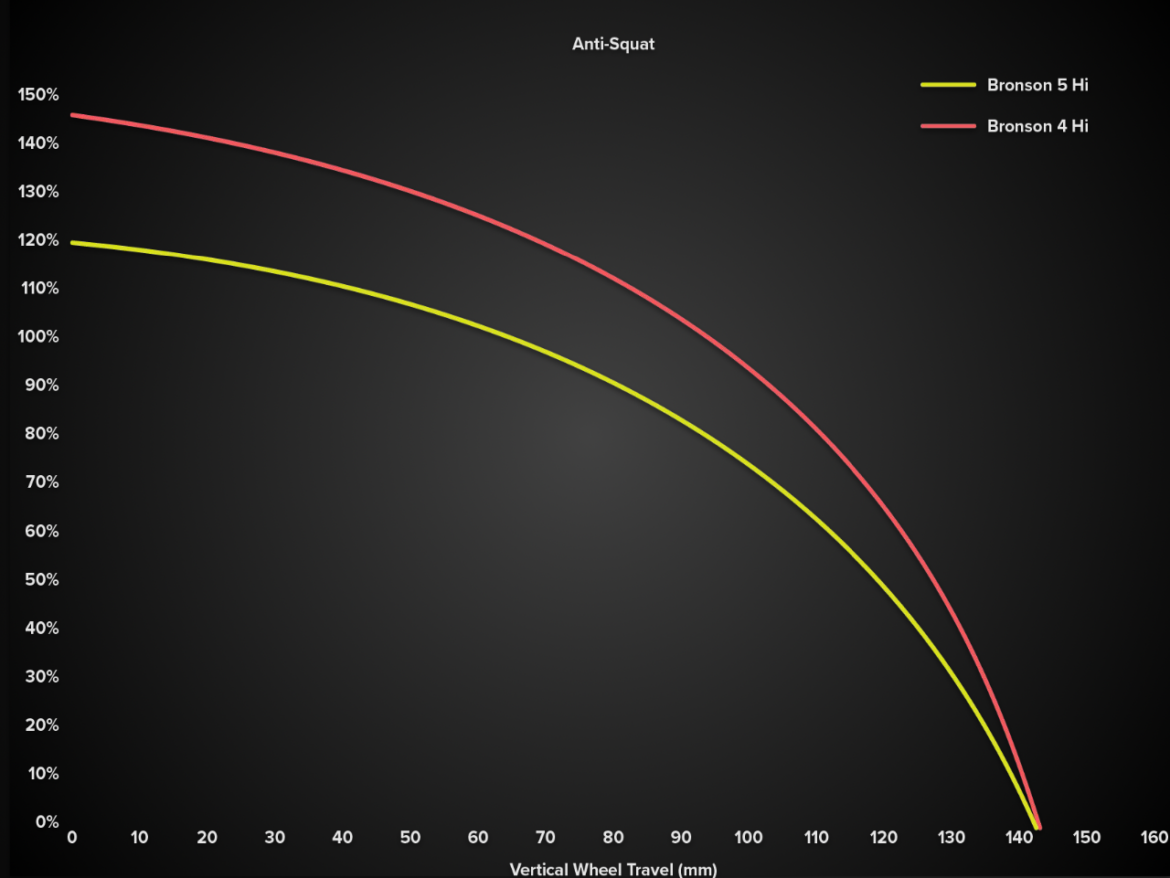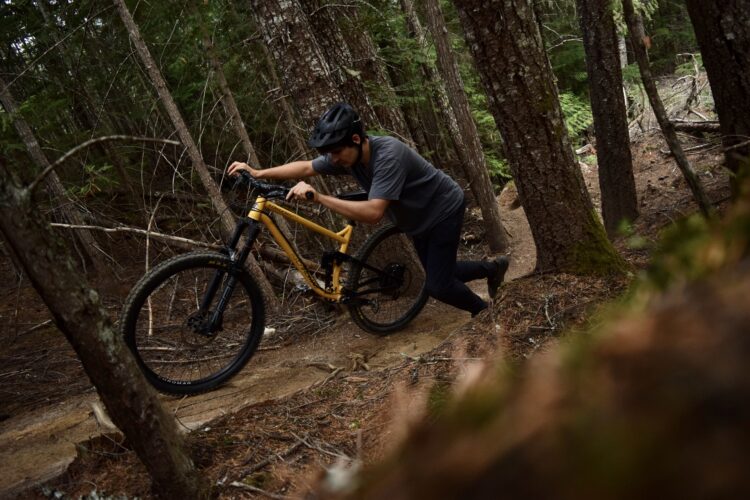
The new Santa Cruz Bronson 5 is here, and it looks, well, fairly similar to the old one, though different enough to be a welcome change. In a time when bike design is getting pretty convergent, many bike manufacturers are making small refinements with their new launches, rather than major overhauls. It’s fair to say that the Bronson 5 fits within that category, since most Santa Cruz bikes cast a pretty similar shadow thanks to their lower-link driven VPP suspension design. That’s no bad thing though — Santa Cruz found a design that works, and they’re sticking with it.
The Bronson 5 does mark a bit of a departure from the previous bike though, particularly in the aesthetic department. Santa Cruz is one of those brands that seems to be on a mission to refine their current offerings to be the best riding versions of themselves, rarely content to rest on their laurels. The VPP system hasn’t changed a ton since they went to the lower-link driven shock orientation with the Nomad 4 in 2017. We know it rides well, and the name of the game seems to be squeezing as much performance out of that platform as possible, though the Bronson 5 arguably gets a few more changes than usual.
Santa Cruz Bronson 5 key specs
- Travel: 160/150mm front/rear
- Mixed wheel only
- Lower Link VPP suspension
- Carbon frames only
- Sizes: S-XXL
- Frame features: 2-position flip chip, in-frame storage, high-end carbon frames are wireless only
- Geo highlights: 63.9º HTA, 78.2º STA
- Weight: 32.8lb for the C GX AXS build, size large
- Two colors: Root Beer and Kalimotxo
- Price: $4,999-$8,999 USD
- Buy from Competitive Cyclist

What’s new with the Bronson 5?
There are a number of updates to the Bronson 5, and the most obvious ones are aesthetic. The shock has moved much further down and forward in the frame, widening out the shock tunnel, which is now designed with a cage-like structure. The changes here aren’t purely aesthetic however; the placement of the shock and links is very deliberate. With the lower link closer to the BB, this helps achieve the desired suspension kinematic that, in short, should be more stable and plush feeling.
We can also see that both upper and lower links have gone on a weight loss program, now sporting significant hollow sections. The hollowed out design in the shock tunnel is presumably also for weight saving, while making it much easier to set sag and change out the geo flip chip too. Speaking of geometry, the new Bronson 5 gets the longer, slacker treatment, although not lower. We’ll dive deeper into geometry and suspension details further down.


Frame details
Getting further into the frame details, the changed aesthetic looks quite different, somehow a little more serious; longer, lower-slung, more like a grown-up enduro bike than a jib machine. Really, that stacks up with the brand’s intentions for this bike, all things pointing toward something more serious and capable.
The higher-grade carbon CC frames are compatible with electronic drivetrains only. Santa Cruz says this enabled them to save weight in the layup by omitting that tube-in-tube routing. This will no-doubt leave some customers unhappy though. While the industry is clearly going down the electronic route and I get it, I say give us the choice to run mechanical too. And while you’re at it, give us commonwealth riders an option for moto brake hose routing. Thankfully, the lower-grade carbon C frames feature mechanical routing, and if you’re the type of person who buys the cheaper build and up-spec, you could do much worse. Santa Cruz C frames are better than most other brands’ high-end offerings.
Outside of that, we’ve got a lot of familiar features, including tube-in-tube routing, Boost 148mm hub spacing, a threaded BSA BB shell, two-position geo flip chip, standard eyelet shock, tapered integrated headset, 31.6mm seat post, UDH-compatible back end, ISCG05 chain guide mount, 2.5″ tire clearance, 180mm post mount, and a lifetime frame warranty.



Suspension
Suspension is one of the biggest changes on the Bronson 5. Santa Cruz engineers have moved the bottom link down and forward, closer to the bottom bracket, with the main aim of reducing anti-squat. Yes, you read that right; while most brands have been working to increase anti-squat, Santa Cruz is looking to decrease it, and bear with me, this might be a good thing.
Anti-squat refers to how much the suspension stiffens up while pedaling. Lots of anti-squat results in a platform that’s very stiff and, in perfect lab conditions, very efficient. Less anti-squat means the suspension can be more active while pedaling, which in the real world translates to better compliance over bumps, and ultimately, grip. In theory, at least. Conversely, this also means that the suspension has less effect on the pedals when it cycles, ie on the descents.
All of this means two things:
- More active suspension while climbing, more grip over loose/uneven ground, for example, technical climbs. Less wasted energy, spinning out. This may come at the cost of a less efficient pedal platform, however.
- Less pedal feedback while descending, more sensitive and supple suspension feel over rough ground. Increased stability and a more confident ride feel. Again, this may come at the cost of less efficient pedaling.


Santa Cruz Bronson frame geometry
The geometry on the Bronson 5 mirrors the changes we’ve seen in the suspension department, trending toward longer and lower, for a more stable and confident feeling. Will the Bronson 5 be less of the playful trail bike we know, and more of a planted and stable descender?

As usual, the Bronson has a two-position flip chip at the lower shock eyelet, allowing the rider to flip between hi/low positions, and includes size-specific chainstay lengths and seat tube angles. This puts the head tube angle 0.6º slacker at 64.2/63.9º and the seat tube angle 1.3º steeper at 78.2/ 77.9º in a size large. Reach grows by 5mm to 478/480mm, and chainstays by 5mm to 442/443mm.
Santa Cruz says the longer chainstays help the bike feel more balanced, since a mixed wheel setup biases the rider’s weight to the rear. Longer chainstays move the rider’s weight forward, and help to weight the front wheel more, preventing it from losing grip and washing out in corners, or on steep sections of trail, thanks to a more balanced fore/aft position on the bike.


Spec
There are five builds and two frame colors available — Root Beer and Kalimotxo — in five frame sizes, S-XXL.
The spec is the final piece of the puzzle when it comes to the new Bronson’s intentions. Every bike comes with a Maxxis Maxxgrip Assegai/Maxxterra Minion DHR II tire combo, and all AXS bikes come with SRAM’s powerful Maven brakes. Build specs start at C R with a Lyrik Base and Fox Float shock, SRAM NX Eagle drivetrain, SRAM DB8 brakes, and Reserve 30 TR 6061 rims on SRAM MTH hubs. The C S builds upgrade to a Fox 36 Performance fork and Float X shock, SRAM GX Eagle drivetrain, SRAM DB8 brakes, and Reserve 30 6061 TR rims on DT Swiss 370 hubs.

The C GX AXS build (tested) gets the GX-level SRAM Transmission groupset, Maven Bronze brakes, Fox Performance Elite suspension, and Reserve 30 SL 6061 rims on DT 370 hubs. The X0 AXS build upgrades to the CC frame, SRAM X0 Transmission drivetrain, Maven Silver brakes, Fox Factory suspension, and Reserve 30 SL 6061 rims on I9 1/1 hubs. Finally, the top spec XO AXS Reserve build gets the same build as the previous one, but with Reserve 30 HD carbon rims.

First ride impressions
Hayden Person took the opportunity to swing a leg over the Bronson 5 for a short test ride and had the following to say.
When you hop on the Bronson it feels easy to get along with. The bike has a comfortable climbing position and is relatively efficient for a long-travel bike. Although the shock position has moved, the frame storage still fits a decent amount of tools or snacks in the pouches.
Descending, the Bronson is responsive while pushing in berms and compressions, making it easy to pop, pump, and float over sections of trail. A highlight is the support while cornering; it’s easy to toss the bike out of one corner and into the next. Through tech, the bike feels composed and maneuverable.
A one-word highlight from the build spec is “Maven.” The extra power allows braking zones to be shorter, which helps on tight sections filled with turns. Overall, the Bronson is a floaty, berm railing, grin-inducing ride. Compared to the Megatower, the Bronson feels more poppy and playful, and a little easier cornering with the mixed wheel size. Climbing feels roughly the same in terms of position, though the Bronson is a little lighter.






















3 Comments
Aug 20, 2024
Still getting slacker too. So much for the LLS trend reaching its limits, at least the S part haha.
Aug 20, 2024
It's interesting isn't it, I do think a certain amount of this is just marketing. The Bronson is essentially becoming a Nomad - all of their models have bumped up in travel aided by the fact that Enduro bikes are now filling the gap that freeride bikes left when people stopped wanting to pedal them. If they continue the trend with the 5010 and Tallboy, there'll be a gap at the bottom for a new model, similar to what Trek have done - all their bikes have bumped up a category, and they had to introduce the SuperCal to fill that gap. Are the bikes getting better? Or is everyone just giving their existing models more travel?
Aug 20, 2024